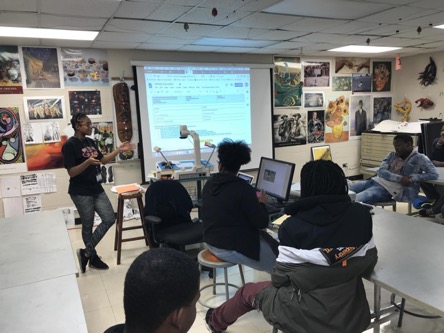Questioning Social Perceptions
By Jiwon Chun
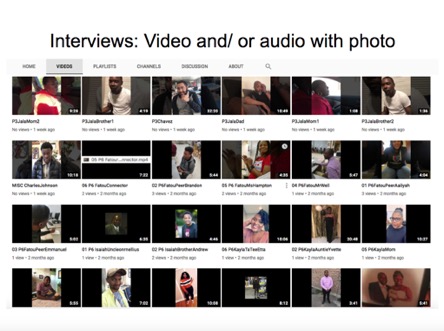
This project involved students in grades 9-12 on the south side of Chicago enrolled in Art 1, Art 2, and AP Art classes. Students worked on the project once a week in a seminar session over the course of six months in this collaborative action that emerged from discussions and dialogue about their community. In recent years, I’ve noticed that many of my students’ artworks and Advanced Placement concentration projects have focused on themes related to violence and other topics that are often difficult to discuss but hugely important to them. Students have reported they do not normally have these challenging discussions with their parents, family, or friends. This project gave students the opportunity to have these conversations with King College Prep students, teachers, families, and people in Chicago neighborhoods and communities (mostly southside). The project revealed how important it is for us to keep an ongoing dialogue on the issues facing our communities.
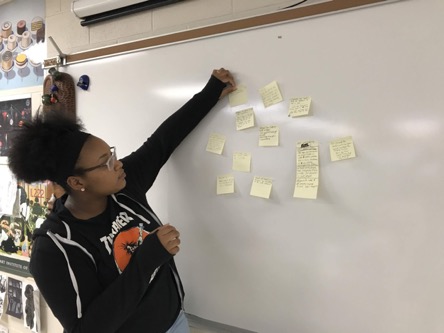
The goal of this project was to give a group of Chicago teens a platform to start a dialogue with their peers and community about topics that are important them. This project provided the opportunity to broach important topics these teens would normally not have the courage or opportunity to explore and helped them to discover difficult truths related to these topics.
Objectives
Students will be able to:
- Start conversations and dialogue with their community about topics of importance.
- Collaboratively identify thoughtful questions to pose to their peers and community.
- Analyze interview responses to find common and unique themes, and represent these findings through video, photo, or digital media.
Guiding Questions
- How do you see yourself and/or your community?
- How do others in the community see you and/or your community?
- How do others beyond the community see you and/or your community?
- If you think this view is wrong or unfair, is there a way to change how your community is viewed by others?
- If you were in charge of the media, what would you show? What would you do to change the perception of how people view you and your community?
- How do you see Chicago in the future? Follow-up: Is this good or bad? If bad, can it be prevented?
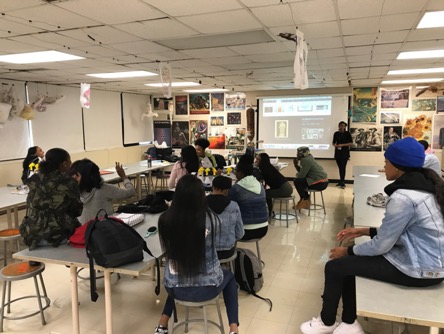
Project Overview
I began by meeting with the History and Math teachers at King College Prep HS to discuss issues our students are facing. I created a presentation for the teachers containing works by numerous social practice artists to use as a starting point to help facilitate this discussion. I then developed a survey consisting of teacher-created questions, and all 5 of my classes completed the survey. The students and I discussed the results of this survey, which students then used to identify topics important to them. The Math teacher provided insight on the survey results using a statistical approach, and the History (AP Human Geography) teacher pursued topics related to the survey questions and results with his students.
Using the themes and topics that emerged from our discussion of the survey results, students began to develop their own questions to investigate. Students analyzed data graphs representing the survey responses and grouped results to identify common themes and topics. The major theme that came out of the initial survey is that the students felt that their perceptions of themselves and their communities were generally positive but felt that those outside of their communities held negative perceptions. Students identified several topics they believed contributed to this difference in perception to explore further: poverty, unemployment, lack of resources, fractured communities, disparities between the south and north sides (resources, cleanliness, general separation, etc.), and violence.
At this point I shared the presentation I originally created for my collaboration with the Math and History teachers with my students, and they gravitated towards artists such as Diana Matar, Chris Johnson, Hank Willis Thomas, Tonika Johnson, Monica Mayer, and Suzanne Lacy, all of whom use multimedia processes to ask questions about the Black community. Students were also inspired by Otobong Nkanga's Body Measured Against the Earth exhibition at the MCA and identified personal connections to the themes of resources and geography in her artwork.
Students determined they would video record interviews with members of their community on the major theme of perception and their previously identified related topics. Art 1 students, with my guidance, created a standardized set of interview questions. All classes were given instructions on how to perform interviews and ask subjects the questions, along with follow-up questions. Students began surveying others using their questions and documented their responses via videos, which were then uploaded to a group YouTube account where students could share the videos.
We met weekly to watch videos of the interviews, take notes on the responses to the questions and discuss the content of the videos. Students provided group feedback on these videos and offered advice on how to improve future interviews. Students edited the videos, searching for common themes among the interviewee’s responses. The students were really excited about this process and were thoughtful in considering how to edit videos to best capture the themes—in fact, they taught me how to edit. The core of this project became the desire to investigate the way our community is perceived. Students are still analyzing, interpreting, and editing the videos as we continue to have discussions and reflect upon the content of the videos.
Students will present their videos as part of a public forum at the end of the school year. After reflecting on their survey questions, the History teacher had his students write haikus that focus on both the negative and positive aspects they discussed regarding their communities. We plan to combine these haikus with similarly themed video interviews for the forum. The students, with help and leadership from the Math teacher, have written questions they would like to ask the Chicago Mayor about how the topics and problems they’ve identified from the video interviews can be addressed. We will present these questions at our public forum and ideally pass along our final product and related questions to our new Mayor.
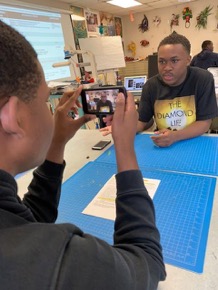

Materials + Supplies
- Camera
- Mic
- Tripod
MCA Connections
Students experienced an artist guided tour at the MCA that helped them to understand contemporary art, the use of non-traditional materials, and artworks that address social issues. Students explored the museum on their own with worksheets, responding to questions related to our social practice project. We reflected on these questions with hands-on activities after our tour.
We used artworks from several exhibitions to generate dialogue around how artists address social issues in their works, including Otobong Nkanga’s To Dig a Hole That Collapses Again, Enrico David’s Gradations of Slow Release, Picture Fiction: Kenneth Josephson and Contemporary Photography, and West by Midwest. These examples helped students connect their project to contemporary art practice.
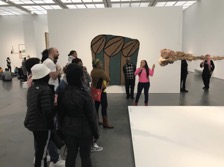
- Picture Fiction: Kenneth Josephson and Contemporary Photography
- Enrico David: Gradations of Slow Release
- West by Midwest
- Otobong Nkanga: To Dig a Hole That Collapses Again
- Diana Matar
- Chris Johnson + Hank Willis Thomas
- Doris Salcedo
- Tonika Johnson
- Monica Mayer
- Suzanne Lacy
- Candy Chang
- Cildo Meireles
- Helio Oiticica
Jiwon Chun
King College Prep High School
About Jiwon Chun
Jiwon Chun moved from Northern California to attend the School of the Art Institute of Chicago, where she studied interdisciplinary art with a focus on sculpture and installation. She began her teaching career 18 years ago on the West side of Chicago, and has since spent the majority of her career teaching at King College Prep High School and Gallery 37. Jiwon is a National Board certified teacher and current chair of the Art Department at King College Prep HS. In addition to traditional classroom lessons, Jiwon takes pride in teaching her students through collaborations with the local art community, such as Diasporal Rhythms, a group of local art collectors focused on works pertaining to the African diaspora. Jiwon is passionate about helping students achieve a better understanding of themselves and the world they live in by working with local artists to expose them to creative and artistic methods of exploration and expression.
Jiwon Reflects on the Project
I have been teaching for nearly 18 years; it has been challenging to embrace the directions where this project has taken me and my students. The project has been unpredictable and often put me in uncomfortable situations of having difficult conversations with my students, but I am learning a lot and embracing the process. Although I’ve always aimed to form a relationship of mutual understanding with my students, the challenging conversations at the core of this project forged a stronger relationship between myself and my students that lasted throughout the school year. As a fine arts teacher, the process has introduced a new media not traditionally practiced in a fine art class for me and my students, since my students chose to express themselves and their findings through multimedia. The project has also been a great tool for collaboration with other teachers in other departments: Just the fact that I was able to talk to my colleagues about these issues is important.
My students embraced the process and gained a better understanding of themselves and each other. It was exciting when students took ownership of the project—they didn’t like the initial questions I was asking and instead created the questions they felt were closer to the issues they face. As the project progressed, my students began to feel what they were doing was important and unique. They started to see the project as more than an assignment. Instead, it became a way to have their voices heard by a larger audience, using various forms of media to bring attention to important issues and improve communication with members of their communities.
Throughout the process, the students and teachers kept asking ourselves: What questions haven’t we asked our community? What are the other issues people in the community want to discuss? I am now thinking about this project as a pilot for the school, and I would like to continue this project next year with a new set of students interested in continuing the conversation.
